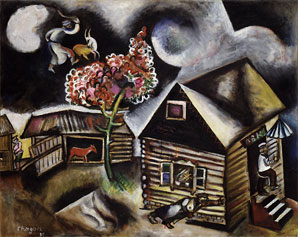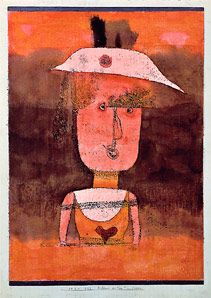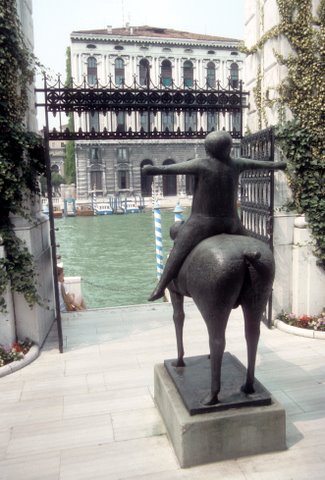One of the world’s most important collections of 20th century art is displayed in the Palazzo Veneiri dei Leoni, overlooking Venice’s Grand Canal. The palazzo was the home of Marguerite (Peggy) Guggenheim and is now the home of the Peggy Guggenhein Collection, a museum much loved by admirers of abstract art.
 Peggy Guggenheim was born in 1898 to great wealth, and when she turned 21, she inherited a small fortune. (Her father, Benjamin Guggenheim, went down with the Titanic in 1912.) Peggy traveled from New York to Paris and there befriended avant-garde artists in Montmartre and began collecting their works. Many of her purchases were created by artists who later became known as the greatest painters and sculptors of the 20th century.
Peggy Guggenheim was born in 1898 to great wealth, and when she turned 21, she inherited a small fortune. (Her father, Benjamin Guggenheim, went down with the Titanic in 1912.) Peggy traveled from New York to Paris and there befriended avant-garde artists in Montmartre and began collecting their works. Many of her purchases were created by artists who later became known as the greatest painters and sculptors of the 20th century.
 Peggy opened galleries in London and France, and after World War II moved to Venice. There she lived in the 18th-century palazzo on the Grand Canal and continued collecting and lending pieces to museums. When she died in 1979, her collection went to the Solomon R. Guggenheim Foundation and in 1980 her former home opened to the public.
Peggy opened galleries in London and France, and after World War II moved to Venice. There she lived in the 18th-century palazzo on the Grand Canal and continued collecting and lending pieces to museums. When she died in 1979, her collection went to the Solomon R. Guggenheim Foundation and in 1980 her former home opened to the public.
Anyone visiting Venice should be sure to see the Guggenheim Collection. It is superb, with masterpieces of Cubism, Abstract Expressionism, and Surrealism. A few of the artists shown are Picasso, Braque, Calder, Mondrian, Kandinsky, Duchamp, Klee, Pollock, and Léger. In addition to art from Peggy’s personal collection, there are pieces that were given to the foundation after her death. Some are on long-term loan, such as the Gianni Mattioli Collection of Italian Futurist works.
 In Peggy’s former bedroom, you’ll see the “bedhead” designed for her by Alexander Calder. It’s a sculpture with entwined fish, insects, and plants, all in silver. There’s also a photograph of Peggy sitting on the bed, holding one of her beloved dogs.
In Peggy’s former bedroom, you’ll see the “bedhead” designed for her by Alexander Calder. It’s a sculpture with entwined fish, insects, and plants, all in silver. There’s also a photograph of Peggy sitting on the bed, holding one of her beloved dogs.
The outdoor spaces are also filled with notable artworks. One sculpture that always gets attention is “The Angel of the City,” a man on a horse facing the Grand Canal. The rider is nude, with a large (and removable) phallus. Legend says that Peggy would order the phallus removed when she knew that nuns would be coming by in their gondola.
Peggy is buried in the garden of the palazzo; beside her grave is a plaque commemorating her dogs. In the “New Wing” there’s a museum shop and a good terrace café. The Guggenheim Collection is open 10 a.m. to 6 p.m. daily except Tuesdays and December 25.


Comments